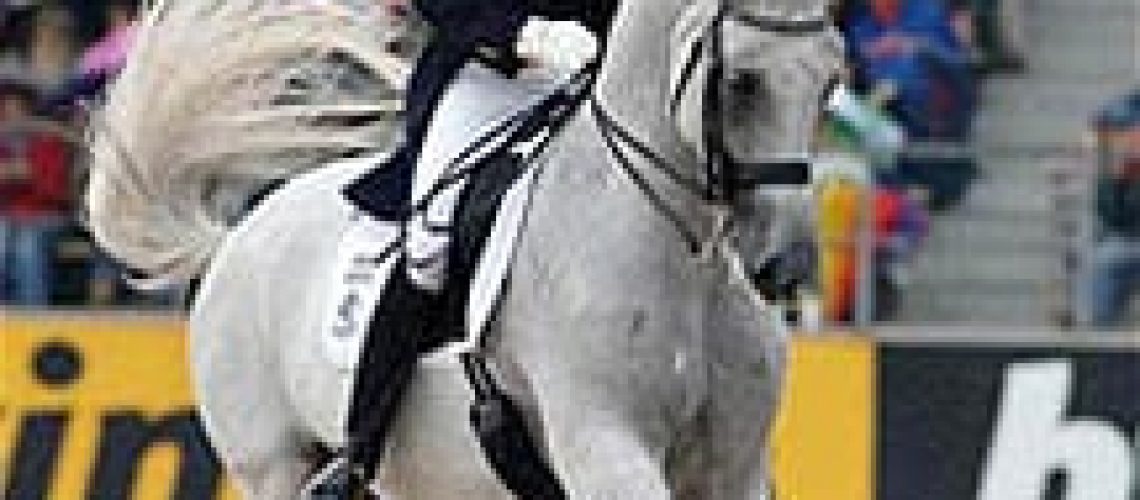Traditional wisdom in training horses is that training a horse through relaxation is preferable to training through tension. But, how many of us can explain why that is, or what it means to train “through relaxation”?
We’ve all seen horses in tension. Look no further than the local riding school to see horses with swishing tails, heads in the air, mouths gaping, wrinkled noses, eyes showing white around the edges, or teeth-gnashing during grooming and tacking up. But many of us don’t notice or aren’t aware of the more subtle signs of tension that are often displayed during training with the trainers we respect or competitors we look up to – things like resistance showing up repeatedly in certain movements, grinding teeth, tight jaws, heavy contact on the bit, tight backs and front legs flinging out with more motion than the hind legs.
With their tremendous skill, years of experience, and love for horses, we believe our trainers would have our horses’ best interests at heart. They would never intentionally develop tension in our horses, they are super successful in the show ring, or our horses have improved dramatically in their training over time. Tension is just a part of life and training the horse, right?
Let’s be realistic. Tension *is* a part of life. Even extreme tension is a part of life in sports. Horses are prey animals prone to flight. Their biologic ability to instantly produce adrenaline, minimize cognitive function in favor of instant reactivity and get away from danger. That ability saved the lives of their wild ancestors. In people, adrenaline can make a mother momentarily strong enough to lift a car off their child or gives someone an extra boost of speed to get away from an attacking dog that they would never manage under normal circumstances. The fact that the mother ends up with torn ligaments and muscles and has weeks of physical recovery to endure later is far overshadowed by the fact that her child is alive. Or the broken bone that results from that extra strong burst of speed is a small price to pay for not being savaged by a dog intent on mauling the person, possibly resulting in their death. So yes, tension is part of life, and it serves a vital function in the continuation of the many species that exist on our planet.
But what about this same type of tension being used in training a physical body to endure greater stress and improve cardiovascular and muscular strength? It’s easy to find this in most fitness centers and gyms throughout our society. Personal trainers encourage their clients to workout faster, harder, and with maximum energy. It’s easy to look to horse racing to see it being used to train horses to run faster and longer. And we can see it in almost every riding sport, where the more spectacular the horse’s gaits appear, the higher they are placed in the competition. This approach is obviously successful. People become stronger and develop greater endurance. Racehorses run faster and longer, and sport horses become more spectacular in their movements. That is the reality. But is it the right thing to do for our horses?
To answer that question for ourselves, we have to be mindful that the horse is an obligate participant in our chosen sport. They don’t get to choose whether they go into training, with whom, or the form that training takes. Some horse people are observant and thoughtful enough to notice if their horse is unhappy in its job and may try something different that they may be more suited to. Still, the majority are plugged into the outlet chosen by their human, which is their lot in life.
I don’t necessarily think this is a negative thing in and of itself. In my more than 35 years of working with horses, I believe their relationships with humans enrich their lives. I believe they can be more comfortable physically and happy mentally with thoughtful conditioning and even training for sport. Nervous or shy horses can learn to be confident and relaxed. Horses with physical challenges can have those minimized and stay more sound for longer through appropriate work.
Of course, we want our horses to be happy and comfortable and confident. With scarce exceptions that I won’t go into here, none of us want our horses to be miserable slaves that do what we ask because there’s no other choice. Knowing that horses are also intelligent, feeling creatures, it places a tremendous responsibility on us, as their owners, caretakers, and trainers, to exercise tremendous empathy and develop an awareness of our horses’ non-verbal communication.
With these seemingly conflicting concepts in mind – that tension is inevitable. Still, we want our horses to be happy and relaxed. It begs the question: is training through tension necessary to achieve our goals for our horses? Is pushing through the tension the only way to develop a horse into a successful competitor? In my experience, as both a human fitness trainer and horse trainer, the answer to both those questions is No, but with a generous dose of reality. Here are the realities of physical training – both human and equine:
- Strengthening muscles requires sufficient stress to be applied to the muscles that the body is stimulated to create additional muscle fibers to adapt to the stress.
- Repetitive muscular stress is painful (you try doing squats uninterrupted for the next 5 minutes and tell me it doesn’t hurt like the dickens! How many breaks does it take you to get through the 5 minutes? And I often see horses required to go 10-15 or even 30 minutes without a break).
- Pain tends to create mental stress. Mental stress tends to result in physical tension.
- Pain and mental stress tend to stimulate adrenaline production.
Therefore, I would submit to the reader that any physical training will result in, and indeed necessitate some amount of tension. It certainly does when I’m working out and pushing myself beyond my current physical or mental limits. I don’t know anyone who can train physically without pain or tension.
Furthermore, horses, being prey animals, have the capacity to work well beyond the point that their bodies will break down. Using physical force or sharp, aggressive aids will induce horses to an adrenaline spike that will allow them to work through pain, fear, or muscular failure – to their detriment.
So, given that tension is unavoidable in training, and horses can easily be induced to work beyond their capabilities, how do we approach training and conditioning for sport so that we can be certain our horses are as comfortable and happy as possible? If it’s unavoidable, why does it even matter, then, if we use the horse’s own tension to train them?
Well, here is another reality of physical training. A muscle in tension is subject to strain when it comes under load. The ligaments and tendons in the joints attached to the muscle in tension are subjected to even greater strain because tension prevents the muscle from having an elastic, rebounding function. This limits joint mobility and requires the support structures to take up more of the load than intended. Muscles that are stressed beyond their normal capabilities due to adrenaline flooding are ripe for excessive stress injuries. Therefore, it would be logical that minimizing tension in the physical conditioning and training the horse would reduce the potential risk of injury. Minimizing injury minimizes pain for our horses, and minimizing pain is a good start to creating happy equine athletes.
In contrast, muscles trained through relaxation will be stronger, healthier, have improved blood flow, and become more elastic, while joints will be healthier in their basic functions than those that are forced to become stronger through tension.
Now the question becomes, how does one encourage relaxation through training, which creates tension by its very nature? Well, therein lies the challenge. These two concepts are not mutually exclusive but rather present a balance to be achieved. As the owners, trainers, and riding partners, it is a challenge for us to make developing relaxation and minimization of tension our priority as we develop our horses to their optimum potential. It’s what we DO with the tension we create in our horses that defines us as horse riders, trainers, and owners.
So, what does it mean to train a horse “through relaxation”?
- It means that we have to notice when our horses begin struggling physically or begin to fatigue, and then backing off, even if *we* haven’t achieved what we were hoping to on that day. Our egos have no place in our horses’ training. We can set our horses up for success or failure. Horses that feel successful will relax and be more confident than horses that feel like they can’t succeed or are forced to keep trying beyond their body’s limit.
- It means we must always be willing to acknowledge and appreciate the horse TRYING, even if they ultimately fail to accomplish what we are asking them to do at any given moment. This develops their confidence to try new things and willing to try just a little harder for us when we ask.
- Sometimes a horse is unaware that it can physically use its body in a certain way. Nothing short of physically inducing the horse to try that particular way of movement will convince them to try it. If we have to correct a way of moving or encounter resistance to our requests, we do our best to make those moments short and to the point rather than prolonging these training moments and escalating tension unnecessarily.
- It also means learning our horses’ personalities and emotional habits – whether they are confident, fearful, shy, nervous, bold, angry, dominant, anxious, easy to frighten, hard to get going, etc., and training them accordingly. It means taking the time to explain things slowly to the shy or unconfident horse so they can develop confidence or being a matter of fact with the dominant horse, or patient with the angry horse, who might have a good reason for being defensive or reticent to give us their full efforts.
- It means always checking through every moment of every ride or training session that you can bring your horseback to a state of mental relaxation, no matter how much tension you have created in any given exercise. This means putting some pressure on for a moment and then backing off when the horse tries or gets something right, giving it a moment to recover physically and mentally before putting pressure on again.
- It means not requiring our horses to give their maximum effort every time we work with them, but to vary their conditioning or training program enough to rest and recover muscles put under stress. You wouldn’t do “leg day” two days in a row because you know that fatiguing those muscles too frequently sets you up for injury.
It also means having grace. Grace for yourself when you go over the limit and committing to doing better next time. Grace for your horse when he or she makes mistakes or acts out in an attempt to communicate something isn’t right. It means putting yourself into your horse’s shoes and really being mindful of what you’re asking him to do in pursuit of your goals. Breathe, relax, and enjoy the ride!

